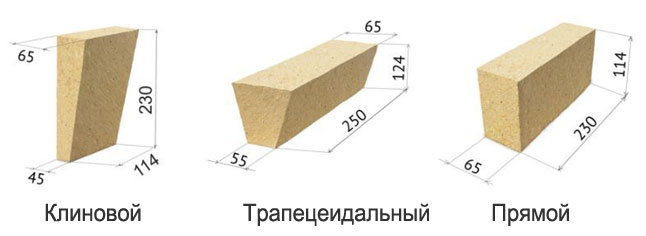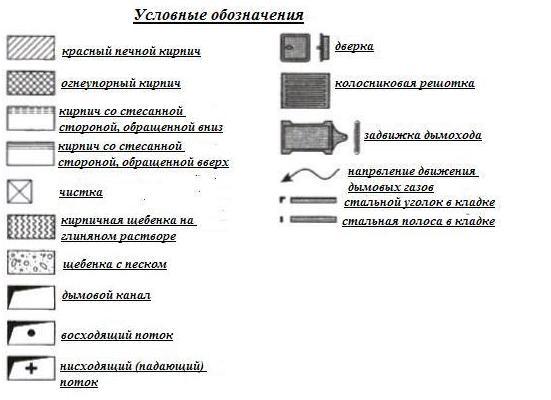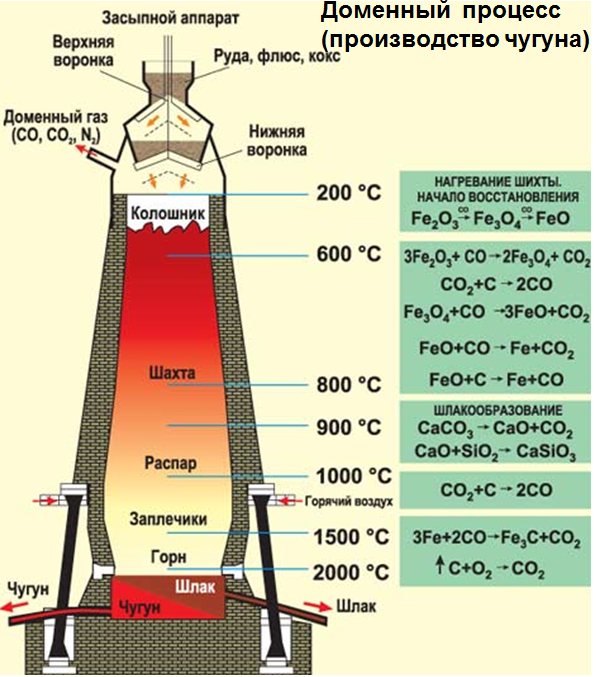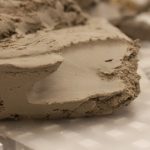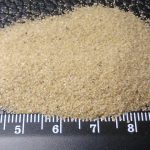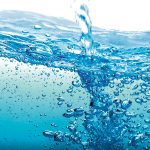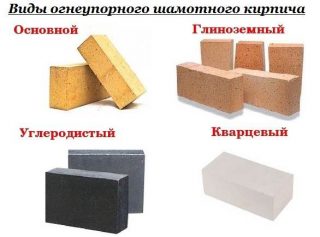Refractory bricks include quartz, carbon, the main types of masonry stones, fireclay bricks are also included in this category. It is most often used for lining when arranging combustion chambers, since the material has high temperature resistance and low thermal conductivity. The brick shell protects the oven masonry from direct interaction with the flame, the elements withstand long heating up to + 1000 ° C, without losing strength.
Description of fireclay bricks
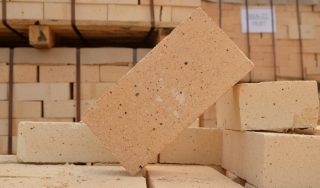
Products are made by firing a mixture of fireclay powder and fine clay with refractory properties. For the procedure, high temperatures are used at different stages from drying at + 200 ° С before sintering at + 1450 ° С.
During the heating process, residual moisture comes out. With intensive release, the product may become cracked, so the temperature is raised gradually. At + 400 ° - + 600 ° C, kaolinite decomposes in solution with additional release of water. General shrinkage in the production process is 2,5 – 3,0%.
how looks like fireclay brick:
- surface has sandy yellow;
- on the spoon, poke and lateral plane is observed grain;
- the dimensions of the refractory bricks correspond to the parameters: 230 x 113 x 65 mm or 230 x 123 x 65 mm.
For front masonry, furnaces are produced wedge-shaped, trapezoidal and rectangular elements.
The technology does not provide for overexposure for more than the prescribed time in critical conditions, since a glassy film forms on the surface. Such elements (iron ore) are strong, but poorly connected with mortar, they are not used in the furnace, only for foundations. Fireclay brick in the marking contains the letter "Ш".
Different types have different characteristics from each other, but an average range of indicators characterizing fireclay refractory bricks can be distinguished:
- fire resistance within + 1000 ° - + 1600 ° С;
- density products ranges from 1700 to 1900 kg / m³;
- compressive strength - 75 - 250 kg / cm²;
- frost resistance - withstands 15 - 20 stages of freezing / thawing;
- porosity material - 3 – 85%;
- heat conductivity coefficient 0.5 - 0.85 W / (m K).
Fireclay brick is different better resistance to alkalis, as opposed to quartz stones.

Scope of application
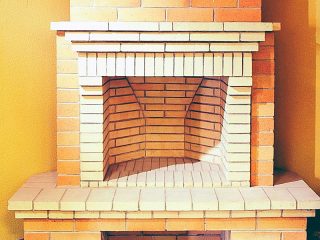
It is used in the most critical places in brickwork, therefore, they pay attention to quality in the manufacture of products. Fireclay brick is intended most often for lining and lining chambers in the design of the furnace for burning wood, coal. The body of the hearth can be made of ordinary red brick, and a heat-resistant brick is placed inside for the firebox.
Lining is an internal lining with a material that is resistant to chemicals, wear, and refractory. It must have low heat conductivity. The lining is used on the closed surfaces of metal-melting furnaces, industrial pouring ladles, boiler furnaces, blast furnaces, mines.
Internal lining functions:
- protects the wall surface from thermal, mechanical, chemical effects;
- in mining metallurgy, the layer protects equipment from impacts, adhesion of sintered substances, abrasion;
- enhances the resistance to direct fire of the main materials of the masonry of stoves, hearths;
- in blast furnaces protects casings from critical temperatures of destruction, interaction with hot metal, slag.
Before laying the oven, make project with ordering drawings... The diagrams show heat-resistant bricks shaded elementsto calculate the right number of parts for installation in the oven. The cost of such elements is higher than ordinary ceramic stones, so the accuracy of calculations comes to the fore.
According to the operating conditions of refractory parts in metal-melting units, zones:
- bottomwhere the forge is located, the area of the tuyeres is characterized by a temperature + 1300 ° - + 1600 ° С;
- upper, where the mine, the steam and the top is located, in it the heating goes up to + 200 ° - + 1300 ° C.
In both areas, fireclay heat-resistant bricks with a high content of white clay are used. The characteristics of the material are of paramount importance in these areas.
Life time material (largely dependent on conditions):
- in blast furnaces - 3 - 10 years;
- in the zone of movement of steels - 40 - 1500 hours;
- in mixers, mobile buckets 20 - 1500 minutes.
Raw materials and composition
The mass for the production of bricks includes about 70% chamotte - refractory clay... It is the main component of the mixture. White kaolin clay is malleable and plastic in its natural state, therefore it is not suitable for the production of solid products with a constant shape. First, the substance is fired, and after hardening, it is ground to a powdery appearance. The result is a refractory clay with all the necessary characteristics of reliability and strength.
Chamotte is made from components:
- refractory fireclay clay;
- sand
- water.
Sand take quartz rocks with content silica at the level of 75 - 80%, it is crushed before being introduced into the raw material mass.
Types of fireclay bricks
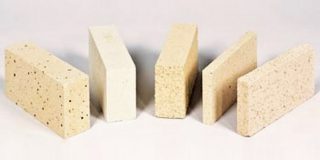
Stone Formation Method serves to subdivide products into types: cast from slip, produced by plastic or semi-dry method, fused, thermoplastic, pressed under high temperatures.
By density fire-resistant bricks are:
- especially dense, they contain no more than 3% of voids;
- high-density products - porosity is not more than 10%;
- dense, with an indicator in the range of 10 - 16%;
- compacted - up to 20%;
- medium density - 20 - 30%;
- highly porous - 30 - 45%;
- lightweight bricks - void concentration 45 - 85%;
- ultra-light materials - over 85% pores.
Some users are worried that the building material can have harmful effects on health, but numerous studies do not confirm this, on the contrary, the natural composition speaks of the environmental friendliness of the material.
- SHA, SHAK, SHB belong to the universal category, from the elements they make fireplaces, household stoves... Durable stones have the perfect combination of value and quality.
- SHUS, SHV have a high heat capacity. They are installed in industrial furnaces for laying out surfaces inside gas ducts and mines.
- PB most often used in construction barbecue, brazier.
- PV also used internally household hearths and fireplace stoves... They make gas tanks in bell-type aggregates.
- ShK - this brand remains indispensable during construction production domain for coke processing.
- SHL belong to the lightweight categories of large mesh, use in hearths and stoves with a low heating temperature (up to + 1300 ° С). They are more often installed in home and small industrial units.
- ShTSU use in mobile buckets with hot metal, also in rotating furnaces.
For cellular materials, porous types of clays and chamotte are used, the latter should be contained in the mass no more than 15 - 20%. For light varieties, clay is used with the inclusion of perlite particles, therefore such products are not able to withstand industrial temperatures, they are used for home stoves, chimney devices. Porous bricks significantly increase the possibility of high-speed heating of the lining, therefore, they are less likely to crack from the resulting steam.
Features of the use of refractory bricks
High-quality bricks for metal-melting furnaces must have a high coefficient of chemical and temperature stability, not conduct gases emitted from the combustion of the fuel mass and the conversion of slags. Increasing the life of mines and blast furnaces is the main focus, therefore, the emphasis is on the use of refractory types of lining. In addition, the material must withstand thermal shock and an aggressive combination of heat, steam and aggressive chemicals (slag, alkali, acids).
For domestic use, small block weight, one product has a mass 3,4 – 4,0 kg. In accordance with GOST 390, such products should not weigh more than four kilograms.
A home stove firebox with a fire-resistant lining saves 15 - 20% more energy than without a lining.
The period of cooling of the furnace hearth matters. The outer walls receive the accumulated internal energy from the chamotte shell, therefore they remain warm for a long time. The use of bricks reduces the amount of opening the combustion chamber door and throwing firewood and coal.
Mortar for masonry of refractory stones

Masonry is carried out using special mixture, the components of which have similar properties to the brick. Standard cement-sand mortar is not used, since it does not meet the requirements. During the operation of a fireplace or stove, it cracks and disintegrates from heating. As a result, the integrity of the walls is violated, poisonous carbon monoxide is released.
Solution requirements:
- viscosity, adhesion to fireclay bricks;
- strength on a par with masonry material;
- attractive appearance (for external walls);
- duration of work;
- heat resistance.
Ready-made dry mixes are sold in hardware stores. They are diluted with water and mixed thoroughly. The disadvantage is the high cost, so such solutions are prepared with their own hands.
Take Components:
- fireclay refractory clay;
- fireclay sand;
- water, it must be soft, for example, rainwater, it does not allow fatty and salty impurities.
The clay is soaked in a container for 2 - 3 days. so as to cover all the substance. Stirred 2 - 4 times a day, after the end of the exposure the clay is rubbed through a sieve with holes 3 x 3 mm.
After that, finely sifted chamotte is introduced sand at a concentration of 1: 2, and water is poured in so as to obtain thick sour cream solution... Check by putting it on a shovel and turning it vertically - while the ideal mass slowly slides off and does not leave a mark on the tool.
Rules for the selection and rejection of bricks
Verification methods are described in regulatory documents, one of which is GOST 54.02.1 - 2000 or GOST 40.69 - 1969... To check the compliance of strength, density and other indicators, you need sophisticated equipmentwhich the buyer cannot have. Therefore, the seller must provide a quality certificate of passed tests in the factory laboratory.
On-site inspection includes:
- identification of chips, sagging, cracking of the surface;
- checking the evenness of edges, edges, squareness;
- sound check - when you hit an element with a hammer, there should be a ringing metallic resonance;
- control of linear deviations from the dimensions of fireclay bricks - should not exceed 2 mm from the standard.


